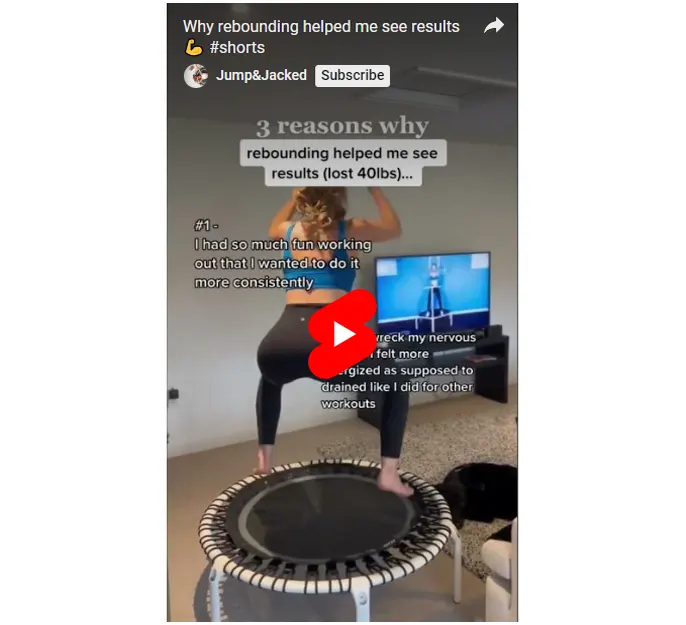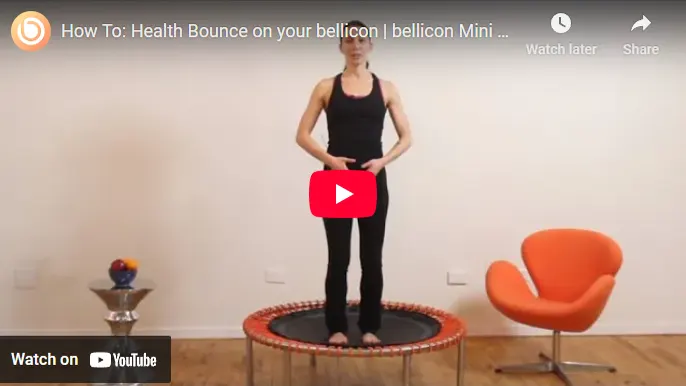The 16 Big Rebounding Myths Debunked
Disclaimer: This website exists thanks to you, the readers. When you buy through links on my site, I may earn an affiliate commission.
If you’ve spent any time looking into rebounding, you’ve probably noticed the bold claims and the hate. From “NASA proved it’s the best exercise on earth!” to “You don’t need a trampoline to detox.”
Depending on which article you read, rebounding is either a miracle workout or barely better than bowling.
The truth? It’s somewhere in between. Rebounding is a fantastic, joint-friendly way to move your body. And, like any form of exercise, it comes with its share of myths and half-truths.
In this article, I’m breaking down 16 of the biggest rebounding myths using scientific evidence where available. From rebounding for weight loss and lymphatic drainage to common worries about health risks, we’ll separate fact from fiction so you can decide what’s really worth believing.
Myth #1: Rebounding is only for kids
You can see where this is coming from. Trampolines are synonymous with fun and play. We don’t associate that joyful bouncing with torching calories or building serious cardiovascular fitness. Rebounding is actually one of the best low-impact workouts for adults. People of all ages use it.
As this particular study puts it:
“The use of mini-trampoline during plyometric exercise may reduce the reaction force exposed by the body compared to landing on a flat surface, as the elastic surface of the mini-trampoline absorbs some of the energy.”
Yes, of course, jumping on an elastic surface is easier on your body than jumping on a hard surface. But if you needed scientific proof, there you have it.
Myth #2: Rebounding is boring
Only if you just bounce up and down forever. With moves like jogging, twists, squats, or even full HIIT sessions, it’s pretty much impossible to run out of ways to mix it up. As a beginner, you can start with gentle bounces, but once you’re ready, you can add weights, intervals, or advanced cardio drills that keep it challenging for years.
Myth #3: It’s just a fad
Rebounding has been around since the 1980s—and it’s still here for a reason. Studies and real-world use keep proving its long-term benefits, from better balance to joint-friendly cardio. And when you see that lots of health-conscious celebrities are using it to stay younger for longer, you know they’re probably on to something. See what Eva Longoria is doing!
Myth #4: Rebounding is bad for your joints
Let’s stop and think about this rebounding myth. Even if you don’t know anything about rebounding, do you really think jumping on an elastic surface can be worse for your joints than jumping on a hard surface? Nope. Of course not.
Getting a good quality rebounder can reduce any potential shock for your joints, just like getting good quality trainers can make your jogging experience better and safer. In any case, a number of studies conclude that rebounding is actually great for your joints. That is, if you don’t have any chronic conditions. If you do, please consult a doctor.
And a safety tip from me: If you want a rebounder that is gentle on your joints, get a bungee one.
Here are my top three recommendations:
Product | Rank | My Rating | Verdict | Price |
|---|---|---|---|---|
1 | Known for its bungee quality, the Bellicon offers an exceptionally smooth and silent bounce that’s easy on the joints, perfect for gentle workouts or recovery. | |||
2 | With adjustable elastic cords, the JumpSport 350f delivers a low-impact bounce that reduces stress on knees and ankles while still providing an energising workout. | |||
3 | The BCAN is a great, affordable option here. Designed with durable elastic bands, the BCAN mini trampoline gives a cushioned, joint-friendly rebound that makes exercise accessible and comfortable. |
Myth #5: Rebounding causes back pain
Rebounding itself is unlikely to cause back pain in a healthy person. If you have any serious back issues like sciatica, then you should consult a medical professional first.
In fact, the bouncing motion strengthens your core and back muscles, which can help prevent pain in the long run.
Myth #6: It’s not for seniors
Totally false rebounding myth. Seniors often benefit the most. Studies show rebounding improves balance and bone density, both key to reducing fall risk. However, I do recommend speaking with your doctor if you have any specific health conditions before you decide to jump on a mini trampoline.
Myth #7: Rebounding can harm your pelvic floor
Done correctly, rebounding engages deep core and pelvic floor muscles, which can actually help with issues like incontinence. A recent study confirmed that rebounding is generally beneficial for people as their age advances, especially women. The paper says:
“Mini-trampoline jumping is a highly beneficial low-impact aerobic exercise capable of improving aerobic fitness, balance, muscle strength, and potentially bone health as well as pelvic floor muscle functioning.”
Of course, it’s best to consult your doctor if you are worried or you have any chronic pelvic floor issues.
Myth #8: It’s not suitable for people with diabetes
Regular exercise like jumping or walking on a mini trampoline can actually help stabilize blood sugar levels in people with Type 2 diabetes. There is even some promising research that shows mini trampoline exercises can help prevent diabetic foot.
Of course, you should be careful, depending on any other health conditions that you may have besides diabetes.
For example, if you are suffering from any type of heart disease, the American Diabetes Association recommends:
“Moderate activity such as walking, daily chores, gardening, fishing. Moderate dynamic lifting, stretching. Activity in moderate climate.”
This means that intense cardio on a mini trampoline is probably a bad idea. However, you can simply walk on it for a few minutes per day, for example, and do other low-impact exercises. Whatever you decide to do, be sure to consult your doctor first.
Myth #9: Rebounding is bad for varicose veins
If you are at a high risk or if you already experience varicose veins, you have to consult a doctor first. Even though it’s a low-intensity workout, jumping on a rebounder puts pressure on the legs.
That being said, bouncing improves circulation and may reduce the severity of varicose veins by keeping your blood moving. The specialists at Texas Endovascular say:
“Jumping (also called rebounding) on the trampoline can help reduce the pooling blood associated with varicose veins. It can also boost your circulation, and help you build stronger, healthier veins.”
Myth #10: Rebounding doesn’t help you lose weight
Now this rebounding myth is definitely not true. Just have a look at all these before and after rebounding weight loss pics. So many people have lost weight with a mini trampoline!
And if you don’t believe me, there is also scientific evidence. Take this 12-week study, for example. Mini trampoline rebounding led to significant fat loss, lean muscle gain, and reduced waist and hip circumferences, along with improvements in blood pressure and glucose control. The researchers say rebounding meets the requirements of the American College of Sports Medicine (ACSM) for weight loss exercises.
Myth #11: Rebounding is not as effective as running
Tell that to your heart rate after 10 minutes. Research shows rebounding burns calories, builds strength, and even helps increase your lung capacity.
As to calorie burn, the American Council on Exercise found it was just as effective as running. In their study, men burned 110 calories in 10 minutes on average when jumping on a mini trampoline, and women burned 83 calories in 10 minutes. This is roughly equivalent to 10 minutes of running.
Whether you choose rebounding or running, you will benefit from the exercise itself. Both will burn calories, but I will argue that rebounding is more fun! 😊
Myth #12: You have to jump high to get all the benefits
One of the biggest misconceptions about rebounding is that you need to leap into the air like a gymnast. In reality, the magic happens with small, controlled movements.
Dr. Brian Cole, internationally recognized orthopedic surgeon and head team physician for the Chicago Bulls, says:
“The proper way to jump isn’t what you would necessarily do naturally. You want to try to stomp down on the trampoline’s surface. And you don’t need to jump very high, just one to two inches is fine.”
Even the gentle “health bounce,” where your feet barely leave the mat, is enough to stimulate your lymphatic system, improve circulation, and work your muscles.
Myth #13: It doesn’t work the core
Wrong again. A rebound session requires stabilize your body, which means your core muscles are engaged throughout—a fact confirmed by multiple fitness reviews and expert observations.
“When you jump, you use the entire momentum of your body, which forces all of your different muscles to work simultaneously,” said Lori Lyons, Exercise coordinator, MBA, AFAA, CWA, in an interview for Cleveland Clinic.
Myth #14: You need expensive equipment
A lot of people assume you have to drop hundreds of dollars on a luxury rebounder to get results. This is yet another rebounding myth. What matters most is the consistency of your workouts, not the price tag on your trampoline.
That’s why I often recommend the BCAN 40″/48″ Rebounder Trampoline to beginners. It’s sturdy, quiet, and big enough to give you space to move. With up to 550 lbs capacity, it’s very good value for money.
You can even start with one of those basic $50 rebounders in Walmart. It can be a great way to test the waters and see if you enjoy rebounding at all.
Myth #15: Rebounders don’t last long
It’s true that cheap rebounders often wear out fast—the mats sag, the springs squeak, and before long you’ve got a wobbly frame collecting dust in the corner. That’s where this myth comes from. But it doesn’t apply to all rebounders. High-quality models are built with stronger mats, better springs or bungees, and sturdier frames, which means they can handle years of daily use without giving out.
If you’re worried about durability, the Cellerciser® is a great example of a rebounder that’s made to last. I’ve had it for years now. You can also see my list of the best rebounders below for handpicked models in various price ranges.
Myth #16: Rebounding equipment is too bulky for home use
This is also a (false) rebounding myth. There are many different sizes of rebounders. Most of them are very easy to store under a bed or in a closet. And, if you’re not using a handlebar, some models make it really easy to fold the rebounder. Below are some of favorite foldable rebounders.
Product | Rank | My Rating | Verdict | Price |
|---|---|---|---|---|
Cellerciser® Tri-Fold Pro Rebounder w/New Streamlined balance bar | 1 | It folds into thirds, comes with a carry case, and you can fold it in 1 minute. This makes it the easiest to use in small spaces or on the go. | ||
2 | This JumpSport model offers a smooth bungee bounce and folds in half for storage. Unfortunately, you will have to do a bit of disassembling. | |||
3 | The BCAN is the most affordable option here. It folds once (in half), which may require you to detach some of the bungees. The good news is it comes with screw-on legs. You can simply remove them and not have to fold it at all. |
Conclusion
Rebounding isn’t magic, and it’s not a gimmick either. The truth sits right in the middle: it’s a safe, joint-friendly way to move your body that can improve strength, cardio, balance, and even mood—without needing a big budget or a lot of space. Most of the myths around mini trampolines come from cheap, flimsy models or from people bouncing without guidance. But with the right rebounder and a little consistency, the benefits are very real.
So if you’ve been holding back because you thought it was “just for kids,” “too easy,” or “too bulky,” now you know better. Bottom line: rebounding is worth trying.
If you want something built to last, the Cellerciser® Tri-Fold Pro is a long-term investment that stays strong for daily use. If you’re more budget-conscious or short on space, the BCAN 40/48 Inch Foldable Mini Trampoline is a great starter option. Either way, ditch the myths and try bouncing—you might just find it becomes the one workout you actually want to stick with.
References and Further Reading
- Bungee Vs. Springs Rebounders: Pros, Cons, and Comparison
- My Honest Review of the Cellerciser®
- How Many Calories Does Jumping on a Trampoline Burn?
- What Size Rebounder Do I Need?
- Rebounding For Lymphatic Drainage: Why And How To Do It
- Rebounding Before and After: What Results Can You Expect?
- Ozdalyan F. et al (2022), Comparison of the biomechanical parameters during drop jump on compliant and noncompliant surfaces: A new methodological approach
- Raczyńska, K., Żurek, G., Barej, R., Pelzer, O., & Lehrl, S. (2015). Mini Trampoline Exercises And The Functional Capacity Of Patients With Spinal Pain
- Aragão, F.A., Karamanidis, K., Vaz, M.A., & Arampatzis, A. (2011). Mini-trampoline exercise related to mechanisms of dynamic stability improves the ability to regain balance in elderly






